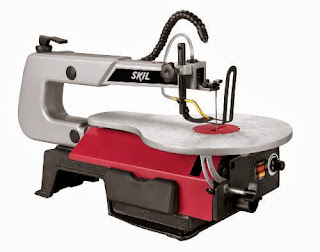Cutting Curves
Band saws and jig saws can cut curves, but as power tools they're fearsome and often dangerous to use. The scroll saw, by comparison, is a domesticated beast. Its strand like blade, which is just 3 to 5 inches long, moves between two parallel arms that pulsate rapidly up and down through a hole in the cutting table. So gentle is the motion, however, that if you accidentally touch the blade with your finger, it probably won't even make a cut.For this reason, the scroll saw is a delight for the hobbyist. It is a favorite for turning out thin wood panels known as fretwork that can be used for boxes or wall decorations, and for creating fancy details for brackets and even the Victorian gingerbread trim used on porches.
Beyond that, scroll saws can be fitted with an assortment of blades that can cut everything from hard acrylic to bathroom tiles with ease, making it a good all-purpose saw as long as the job is a small one.
Speed and Cutting: Choosing a Model
Despite some slight variations, all scroll saws function in a similar way, what distinguishes them is the price and certain features that make cutting easier and more precise.- Low-end: At the low end of the spectrum below $200 lie single-speed models, in which the blade moves up and down at a fixed rate. These machines can effortlessly cut through inch-thick pieces of softwood such as pine and thinner pieces of hardwood, but they may begin to labor if cutting through anything thicker or harder. Beyond their weak cutting capacity, these saws, like low-end cars offer bumpy rides to anyone who uses them. They're noisy, which makes it difficult to tolerate them for long stretches, and they tend to vibrate, which makes it hard to hold down a piece of wood in order to follow the lines on the paper.
- Midrange: Since scroll sawyers tend to spend hours and hours behind the blade, more expensive models include features that make them more comfortable to use. Midpriced models from $400 to $600 vibrate less, and are also quieter. The blades can be operated at two or more speeds or, better still, at variable speeds ranging from 300 to 2,000 strokes per minute. This gives the operator the ability to cut cleanly through thicker pieces of wood. Another important feature for people who use the scroll saw to make intricate cuts is a quick-change blade clamp. This eliminates the need to tighten the blade with a wrench, and can remove some of the tedium of the work.
- Professional: Saws at the high end of the scale upwards of $1,000 have still less vibration, which results in a smoother cut that does not need any sanding at all. These will also contain blowers that whisk away dust from the cut so you can follow the line, as well as lights and magnifying glasses to make it easier to see what you're doing. These features are available on mid priced models as well, making those a better choice for anyone but full-time professionals.
Choosing a Blade
Scroll saw blades come in a profusion of styles and teeth sizes, and choosing one for a job often comes down to a matter of taste. See all scroll saw blades.- In general, precision-ground teeth are harder than regular blades, and rarely break.
- Some blades cut only on the downstroke, but a reverse-toothed blade the most popular choice for hobbyists also has teeth that cut on the upstroke, making for a smoother cut.
- Each tooth on a crown-toothed blade cuts both on the upstroke and downstroke, making it ideal for plastics and veneers.
- Skip-toothed blades, as the name indicates, contain gaps that pull sawdust away so the blades can move without friction. This reduces the risk of leaving burn marks on the wood.
